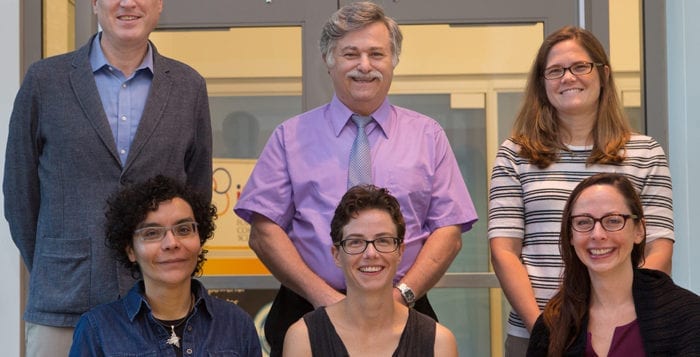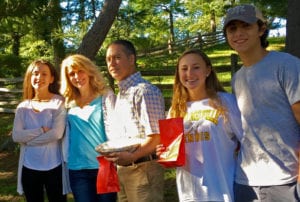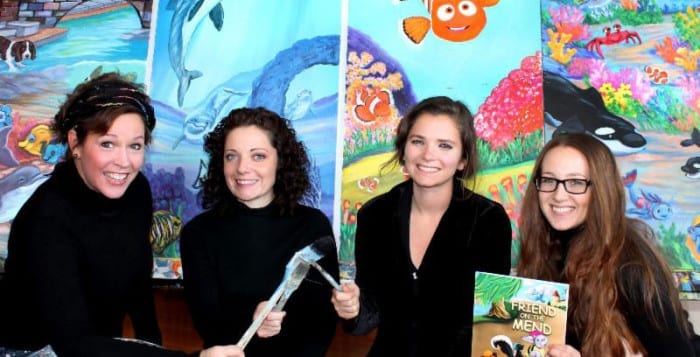Blast from the Past: Do you know when and where this photo was taken? What show are these people getting ready to see? Email your answers to [email protected]. To see more wonderful vintage photographs like this, visit The Ward Melville Heritage Organization’s ongoing exhibit, It Takes a Team to Build a Village, at The WMHO’s Educational & Cultural Center, 97P Main Street, Stony Brook. For more information, call 631-751-2244.
Monthly Archives: October 2016
‘Wizard of Oz’ opens at the Engeman
Dorothy (Kate Keating) greets theatergoer Selah, age 4, of Nesconset, after a performance of “The Wizard of Oz” at the John W. Engeman Theater in Northport on Oct. 1. The children’s show runs through Nov. 6.
A labor of love: A community garden grows in Port Jefferson

By Ellen Barcel
Tucked among the quaint shops on East Main Street in Port Jefferson is an urban oasis.
A community garden came to Port Jefferson this past growing season. The new garden is located in front of the 1812 Captain Thomas Bayles House, right next to the Port Jefferson Free Library on East Main Street. The former home of the Scented Cottage Garden gift shop, the historic building was sold to the library last year. Erin Schaarschmidt, head of teen services for the library, said “there are no plans just yet” for the future of the building, and “public input is needed” with suggestions for its future use, but the front lawn of the property was quickly put to use.

The idea for the community garden came from Anthony Bliss, youth services librarian. Bliss, who works with children and teens, wanted something that the younger children could do. “And teen volunteers are always clamoring for community service,” said Schaarschmidt. “The teens started the seeds in the teen center in spring [which is across the street from the main building]. Then the children came with their families to plant [the seedlings]… the teens have been weeding it to keep up with it.” Even when school started, teens have been coming in the afternoons after school. Commenting on the dedication of the teen volunteers, Schaarschmidt noted, “The teen volunteers even came when it was 90 degrees or more and in the rain. It really was a labor of love.”

The garden featured several types of tomatoes and peppers in raised beds. Welcome Inn, a soup kitchen in Port Jefferson, was the recipient of the bounty. But vegetables were not the only plants raised in the community garden. Lots of annuals including sunflowers, impatiens, zinnia and salvia, many in colorful planters decorated by a local Girl Scout group, filled the garden, as well as herbs such as basil and mint. There was even an aquatic garden with water hyacinths and a fountain. Painted rocks placed carefully along the beds completed the picture.
The brightly colored birdhouses that adorn some of the larger perennials in the garden, such as the beautiful hydrangeas, are embossed with the letters PJFL. But what is more unique about them is that they were made using a three-dimensional printer that the library owns. A 3D printer makes objects from a digital file. So instead of printing out a photo of a birdhouse, the 3D printer produces the birdhouse itself. Using PLA, a type of biodegradable plastic, the teens created the colorful additions. The library owns the printer, but currently it is used only for special programs. “It takes one to two hours to print each thing,” said Schaarschmidt, so the process is time consuming, but “in the future [the public] will be able to use it.” She noted that the library is working out details, including the cost.
Now that autumn is just about here, plans include putting in a fall display of mums and corn stalks. Noted Schaarschmidt, “The Friends of the Library will be having a small sale of pumpkins to raise money for the library on Oct. 22.” She added, kids will be able to have their photos taken. “It will be a family event.” Check the library’s website, www.portjefflibrary.org, for specifics, or call 631-473-0022 closer to the date.
Community gardens have so many benefits: produce for those who can’t afford it, service for local volunteers and, of course, the beauty of the plants themselves. They increase local property values and they cut down on the distance food must travel, helping to control pollution, to name just a few. For further information on community gardens, especially if you are interested in starting, or taking part in one, can be found at the American Community Gardening Association website: www.communitygarden.org.
Ellen Barcel is a freelance writer and master gardener. To reach Cornell Cooperative Extension of Suffolk County and its Master Gardener program, call 631-727-7850.
New SBU graduate student training program scores $3 million grant

By Daniel Dunaief
If Stony Brook University has its way, the university will stand out not only for the quality of the research its graduate students produce but also for the way those budding scientists present, explain and interpret their results to the public and to policy makers.
Pulling together faculty from numerous departments across the campus, Robert Harrison, the director of the Institute for Advanced Computational Science, created a program that will teach graduate students how to use big data sets to inform difficult decisions.
The institute recently received a $3 million grant from the National Science Foundation Research Traineeship for this effort, called Science Training & Research to Inform DEcisions, or STRIDE. The grant will be used for students in the departments of Applied Mathematics and Statistics, Biomedical Informatics, Computer Science, Ecology and Evolution and the schools of Journalism and Marine and Atmospheric Sciences.
“This is unique,” said Arie Kaufman, a distinguished professor and chair of the Department Computer Science at Stony Brook. “It’s a new kind of approach to training and adding value to Ph.D. students.” Indeed, the students who complete the STRIDE training will earn their doctorates and will also receive a certificate for their participation in this program. Students in the participating departments will need to apply for one of the 10 positions available in the program next year. The partners involved in this program expect it to expand to 30 students within five years.
Kaufman said what enabled this collaboration was the range of skill sets across Stony Brook, including the Alan Alda Center for Communicating Science, which is a growing program that already offers the type of training more typical for an actor studying improvisation techniques than for a scientist studying neurotransmitters or DNA.
The Alda Center is “creating a new course,” said Christine O’Connell, an associate director at the center and assistant professor in the School of Journalism. She is currently working on developing the course description, which will include communicating to decision makers. O’Connell, who has a doctorate in marine and atmospheric sciences, sees her work with the Alda Center and with STRIDE as the “perfect combination in bringing the decision making piece to work with scientists to help them talk about their research.”
Scientists who take courses at the Alda Center with STRIDE learn how to understand their audience through various role-playing scenarios. They will also develop their abilities to present their goals or messages in a visual way and not just talk about their work.
Heather Lynch, an associate professor in the Department of Ecology and Evolution who is also a co-principal investigator on the STRIDE grant, will help design the program, mentor students and develop courses. She’s been involved with this proposal since its inception, over three years ago. “In many ways,” she explained in an email, “my interest stems from my own difficulties communicating effectively with policy makers, and finding tools and visualizations that are compelling to a non-scientist.” Lynch recounted her frustration with presenting science to help a policy making body, such as a committee, with the kind of analysis she believed they were seeking. After she did her best to answer the question, the committee sometimes dismissed her work as not being what they wanted. “That’s frustrating because that means I failed at the outset to define the science question and that’s what I hope we can teach students to do better,” Lynch explained.
Lynch said she wishes she had the training these students will be getting. For scientists, computers are an invaluable tool that can help delve into greater breadth and depth in analyzing, interpreting and collecting information. The STRIDE effort includes a greater awareness of the way computers can inform political or social science. Researchers generate “tremendous amounts of data that can be used to analyze trends or detect diseases,” Kaufman said. “The data science is tremendous in every discipline.”
The faculty who are a part of this program said they have already benefited from the interactions they’ve had with each other as they’ve developed the curriculum. “I know a few people in Ecology and Evolution and I know more people in Marine Sciences, but these particular individuals were new to me,” said Kaufman. “We have already been communicating about ideas for how to use the Reality Deck for other projects.”
Completed in late 2012, the Reality Deck is a $2 million rectangular room in the Center of Excellence in Information Technology building. The room has hundreds of monitors that cover the wall from floor to ceiling and provides a way for researchers to study images in exquisite detail.
Other scientists in the program include Liliano Dávalos, an associate professor in the Department of Ecology and Evolution, Janet Nye, an assistant professor in the School of Marine and Atmospheric Sciences, Joel Saltz, the founding chair of the Depatment of Biomedical Informatics, Erez Zadok, a professor in the Department of Computer Science and Mighua Zhang, a professor in the School of Marine and Atmospheric Sciences.
Lynch said the program will bring in people who are working on real-world problems, including those in government, industry and nongovernmental organizations who are “in a position to take science and use it for practical purposes.” As a part of the program, the scientists will monitor the progress of the STRIDE candidates, O’Connell said.
The evaluations will check to see if “they become better communicators and better at interpreting their data for different audiences,” O’Connell said. “The evaluation piece built in will help us assess the program.”
Photo of the Week
AUTUMN SUNSET
Elisa Hendrey of Sound Beach captured this gorgeous sunset over Mount Sinai Harbor on Sept. 26 using her iPhone 5.
Send your Photo of the Week to [email protected].
Let’s Eat: Apple Pie Delight

The Long Island Apple Festival returned to the Sherwood-Jayne Farm in East Setauket on Sept. 25 for its 27th year. Presented by the Society for the Preservation of Long Island Antiquities, Homestead Arts and the Greater Port Jefferson–Northern Brookhaven Arts Council, the event celebrated the humble apple. One of the highlights of the day was the apple pie contest. First place went to Sabrina Sloan and Chris Muscarella of East Setauket (see their recipe below), Erin Lovett of Lake Ronkonkoma took home second place and Christopher McAndrews of Belle Terre placed third. Liana and Gabrielle Lofaso of Belle Terre won for Best Looking Pie. Congratulations to all!
Apple Pie

YIELD: Makes one 9-inch pie, serves 6 to 8
INGREDIENTS:
Crust: 2½ cups all-purpose flour
3 teaspoons sugar
¼ teaspoon salt
1½ cups (3 sticks) cold, unsalted butter, cubed
½ cup ice water
Filling:
8 cups cored, peeled, sliced apples (Granny Smith or Cortland)
2 tablespoons lemon juice
¼ cup all-purpose flour
2/3 cup sugar, plus 1 tablespoon for top of crust
¼ cup brown sugar
1 teaspoon cinnamon
¼ teaspoon nutmeg
2 tablespoons butter
1 egg yolk
Splash of water
DIRECTIONS: Preheat oven to 375 F. In a food processor, using a metal blade, pulse your flour, sugar and salt together. Add in cold, cubed butter and pulse. Slowly drizzle in ice water, one tablespoon at a time. You should have a course, crumbly mixture. (If you don’t have a food processor, combine ingredients in a large bowl using a pastry blender or fork.) Before the dough has formed a ball, remove the blade and take dough out, bringing it together by hand. Form the dough into a disk, wrap in plastic wrap and refrigerate for at least 2 hours. It is very important to work with cold dough. In a large bowl, toss apples in lemon juice, flour, sugars, cinnamon and nutmeg. Set aside.
Once dough is cold, take dough out of plastic wrap and divide in half. Return one half, in plastic wrap, to the fridge. On a lightly floured surface, roll your ½ of dough out into a circle, 12 to 14 inches round and about ¼ inch thick. Gently take the corners, lift the dough and transfer it to pie pan. Lightly press sides against the bottom and sides of pan. Trim overhanging dough so that you’re left with ½ inch and fold excess under the edge of the pan. Pour apple mixture into pie pan and cover the top of the apples with pats of butter. T
ake second half of dough from fridge and repeat process of rolling it out to a 12 to 14 inch circle, ¼ inch thick. Cover the entire pie with remaining rolled-out dough. Pierce holes in the top of dough to allow heat to escape (so there isn’t a steam buildup inside the pie.) Seal the edges of the pie by fluting the dough (stamping the dough with a fork) around the edge of the pie pan. In a small bowl, beat the egg yolk and add a splash of water. Brush the egg mixture all over the top of the crust and sprinkle with sugar. Bake for 50 minutes or until crust is golden brown.
Recipe courtesy of Sabrina Sloan and Chris Muscarella of East Setauket.
Eye on Education: SBU strives for gender equality with new diversity plan
By Dr. Samuel L. Stanley
Implementation of Stony Brook University’s new Plan for Equity, Inclusion and Diversity is off to a great start, with several initiatives underway to take us to the next level in enhancing student, faculty and staff diversity and building an inclusive community.
Gender equality is one of the focal points of our plan. As one of 10 University IMPACT Champions worldwide for UN Women’s HeForShe movement, Stony Brook is committed to being a national leader in gender equality and serving as a model for other colleges and universities.
HeForShe encourages men and boys to become agents of change in achieving global gender equality by building on the work of the women’s movement as equal partners, crafting and implementing a shared vision of gender equality that will benefit all of humanity. For Stony Brook, HeForShe provides a visionary and sound foundation from which we can work to improve diversity and the human condition on our campus and beyond.
To highlight our commitment to achieving gender equality, Stony Brook University co-hosted the HeForShe second anniversary event, welcoming world leaders, activists, change-makers and celebrities to the Museum of Modern Art in Manhattan on Sept. 20. At the event, we celebrated the launch of the first HeForShe IMPACT 10×10×10 University Parity report, which charts Stony Brook’s progress toward gender equality along with nine other leading universities from around the world.
Some of our progress includes building gender sensitization programming and gender equality themes into our mandatory freshman seminar class; forming a HeForShe Steering Committee of students, faculty and staff to oversee the implementation of our commitments; and hosting the first SUNY-wide HeForShe conference last March to work with all 64 SUNY campuses in developing programs to increase gender equality, giving us the potential to impact the experiences of more than 459,000 students and almost 90,000 faculty and staff.
Stony Brook is also now a leader in the field, offering the first-ever master’s degree program in masculinities studies within the university’s Center for the Study of Men and Masculinities led by Distinguished Professor of Sociology Michael Kimmel.
On Sept. 12, Stony Brook welcomed Phumzile Mlambo-Ngcuka, executive director of UN Women and under-secretary-general of the United Nations, who delivered a timely and provocative lecture to our students, faculty and staff. To quote Mlambo-Ngcuka: “There aren’t enough universities in the world that have put this issue at the center of our work. It is in universities where we produce thought leaders and people who can truly change the world.”
Stony Brook is proud to be a pioneering university in our progress toward gender equality. Visit stonybrook.edu/diversityplan and stonybrook.edu/heforshe for more information.
Dr. Samuel L. Stanley Jr. is the president of Stony Brook University.
Splashes of Hope celebrates 20 years of healing with paint
By Wenhao Ma
Splashes of Hope, a nonprofit organization based in Huntington that provides murals for medical and social service facilities to create welcoming environments that facilitate healing turned 20 this past month.
Years ago Heather Buggee, creator of Splashes of Hope, was just an art school student with a close friend who was suffering from Hodgkin’s Disease. While he was being treated, Buggee said the two friends talked about how positive imagery and an appealing environment would help patients relax and support the healing process while they stayed in a hospital.
Her friend did not survive the illness— but Buggee decided to keep their dream alive.
In 1996, Buggee created Splashes of Hope.
“Environment is very much a part of the healing process,” Phil Rugile, president of Splashes of Hope board said in a phone interview. “Splashes fills that gap, and if nothing else gives a child a few minutes of respite from whatever scary event brought them to the hospital in the first place.”
Senior mural artist, project manager, and daughter of Buggee Sarah Baecher said the organization was started in her mother’s basement. Now Splashes of Hope is located inside Coindre Hall, a mansion built in 1912 that is now owned by Suffolk County, fit with an office and art studio. They have been there for the past 15 years.
There are four artists working daily in the office, but Baecher said the nonprofit has more than 50 volunteers on Long Island and more than 100 nationwide. With the help of volunteers, Splashes of Hope has worked on projects across the country and world.
“To date we have ‘splashed’ thousands of focal points and murals in children’s hospitals across the U.S., local Veteran’s homes, shelters, psychiatric clinics, cancer centers, nursing homes, orphanages in Ukraine and hospitals in Paris, Cairo, Nicaragua and Rome,” Buggee said in an email.
To create murals, artists would first visit the hospital or facility to see how their creation would best fit in the room. Then they can either paint directly on the walls in the facility or on removable panels in their studios, which are later installed in the facility.
“We work with the staff in the hospital and see what kind of theme they need for patients,” Baecher said. “In asthma centers, we want something where you can breath, like an open sky with some birds flying around. In psychiatric centers, you don’t want stimulus. We do a lot of open water scenes.”
Other than painting for public facilities, Splashes of Hope also does murals for the bedrooms of children with life-threatening illness, with artwork that shows off their favorite things.
Ethan Chang, 13, is one of the children who received a mural , Chang has degenerative brain disease, and five years ago, he was granted a wish by Make-A-Wish Foundation, an organization that grants the wishes of children with life-threatening medical conditions. Dave Gussaroff, who was Chang’s “wish granter” at that time, called Splashes of Hope and asked if they could do a mural for Chang’s bedroom.
Since then, Chang and his parents, Thomas and Ann-Marie, have been involved with the organization. According to his mother, Ann-Marie, Chang loves painting with Baecher and Buggee, and several of his paintings are now hung in the organization’s studio.
“I’m here because of [Buggee],” Ethan’s mother said in an interview, who is now a volunteer for Splashes of Hope. “She got my son interested. Then he brought my husband and me in. You can feel her love and passion for what she does and it makes you want to be a part of it. There’s a million places that we could have chosen and wanted to spend time and volunteer for. And we have done volunteer work for other organizations. But when you come here, there’s a different feel.”
Original owner of Port Jeff bar sets record straight

By Billie Phillips
My name is Billie E. Phillips. Thirty-five years ago, my late first wife and I, borrowed every dollar we could and spent every dime we had to open up the Bar/Restaurant, Billie’s 1890 Saloon. Like every venture into the hospitality business, it was a gamble. We were very fortunate. Through the first years it became apparent that Billie’s was becoming a special place for the community, a place for stories to be told, laughs to be had, and new memories to be made.
Since then and after my sale of Billie’s it has maintained its standing as part of the fabric of the community. Unfortunately, as most of you know, Billie’s sustained a kitchen fire and has been closed since late June. Since then, the current tenant’s lease was cancelled for reasons many people have speculated about, but most people have no true knowledge of.
Rumors have spread to the point that petitions were started to save the building from being torn down. The building will not be torn down and the bar and restaurant you have grown to love will continue on in the tradition of Billie’s 1890 Saloon for as long as I have a say in the matter.
After a brief tour of the building by the landlord, I was asked if I would be interested in leasing the property, as a new lease would not be offered to individuals of the previous corporate tenant for reasons that were explained to me. After some contemplation, I felt the reasons were understandable.
At the end of the day, I could not stand by and watch Billie’s 1890 Saloon be taken over by anyone without ties to the Port Jefferson community. In a decision that was very difficult to me because of friendships I have with people connected to Billie’s, in many capacities, my family and I have assumed control of the space used by Billie’s 1890 Saloon. It is my hope people will begin to understand this could have been the end of Billie’s as they knew it, and to some it will probably still feel this way. However, to those that are skeptical, please know my family and I will endeavor always to maintain the intangibles that make Billie’s such a special place in the hearts of so many.
Billie Phillips is the original owner of Billie’s 1890 Saloon, located on Main Street in Port Jefferson.
Smithtown West scores sixth straight win
League III's No. 1-ranked Bulls tally fourth shutout in last five games
By Desirée Keegan
Brandon Erny has now scored the game-winning goal in four of the last five games for Smithtown West boys’ soccer team.

In the Bulls’ 2-0 victory over Huntington Oct. 10, Erny knocked in Smithtown West’s first goal with 22 minutes left in the first half.
A senior co-captain, Erny made his way through midfield and passed the ball to junior Andrew McDonnell at his left. Erny then booked his way to the top of the box, grabbed the ball back from McDonnell and tapped it into the far left corner for the early advantage, and ultimately his team’s six straight win.
“I just wanted to get the ball up top,” he said. “I made the quick pass to Andrew and wanted to get the ball back as quick as possible. This was an important win today.”
Senior co-captain Aaron Siegel made multiple leaping grabs throughout the first half to preserve his clean sheet.
“I felt good today,” he said. “I was vocal; did really good in the air. All of their chances were basically long throw-ins, which I came out collecting. I was good on the line today and the back row did pretty well too, so that helped a lot.”

Huntington senior defender Matthew Gelb, with his mighty throw-ins, gave his team much of their chances at a goal, but the forwards had trouble capitalizing on any opportunities at the net. Huntington junior goalkeeper Nat Amato was also strong between the pipes.
Less than three minutes into the second half, McDonnell received the ball in the first half of Huntington’s zone, and moved it toward Amato — who started coming out of the box — and failed to beat him out as the goalkeeper made the stop. Amato did the same on a rebound opportunity. A minute later after a corner-kick send in, McDonnell got his head on the ball for the 2-0 lead.
Siegel said he knew Huntington was going to be a formidable opponent.
“It’s a tough win every year,” he said. “Huntington is really tough; always challenging. They have a coach over there who gets them energized. They always come at us full speed.”
He said his team stayed focused on Friday during practice to earn the win, his fifth shutout of the season and third at home, and will hope to do the same this Friday when his 10-1 top-seeded team takes on No. 2 Newfield (9-1-1 League III).

Siegel said the game will help them prepare for a postseason push. The co-captains are aiming for the county finals.
“We’re going to get playoff ready — playoff-speed ready — because there’s nothing like playoffs,” Siegel said. “Whether you’re the No. 16 team or the top seed, every team is coming at you, everything team is good and every team is fired up.”
Erny said heading into the matchup that the team will work on its defense against the closely-ranked Wolverines in the hopes that the Bulls can hold it down in the remaining two games against West Islip and Centereach to claim the League III title.
Newfield handed the Bulls their only loss this year. A 2-0 defeat Sep. 17.
“I’m looking for revenge,” Siegel said. “They took one from us on our own field and that’s the only time I’ve ever lost in three years playing here. It’s not going to happen again.”











